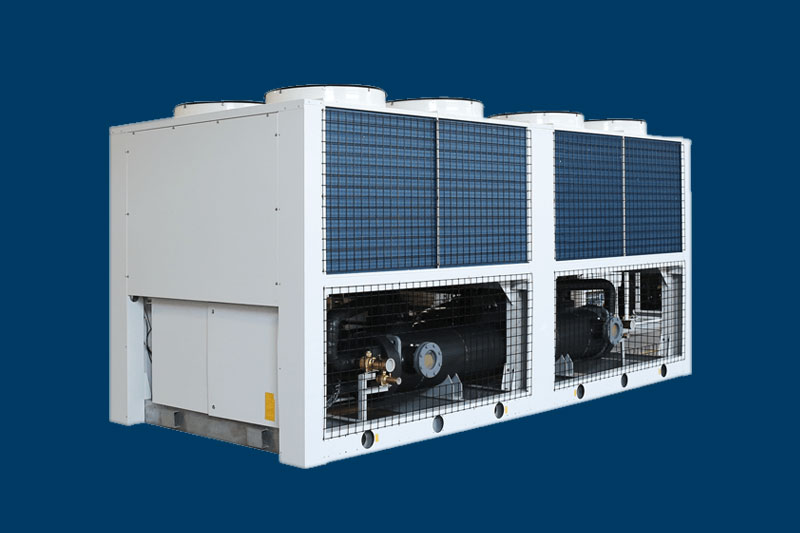air cooled chiller
Chiller
Chillers of Sepand Air Conditioning Company can be offered in two models of air and water chillers. Other capacities as well as compressors are offered in hermetic, scroll and screw types according to the customer’s demand.) In all the produced chillers, electrical protection and control equipment and parts are used.
Compressors, valves and electrical, electromechanical and mechanical equipment are selected from the best reputable Western European and American brands.
Features of Sepand ventilation chillers:
Reducing the footprint (requires less space for installation)
Decrease KW/TR (Increase IPLV)
Reduction of Inrush Current (need less startup current)
DBA reduction (less noise)
Aircooled Screw Chiller
Screw water cooled chiller
Watercooled Screw Chiller
Modular Aircooled Chiller

What is a Chiller?
A chiller is a device that uses a thermodynamic cycle, a compression absorption cycle, or a steam cycle to transfer heat from a refrigerant or fluid stream. The resulting cooled fluid circulates through a heat exchanger to cool water for various uses. Essentially, a chiller absorbs heat from its surroundings and transfers it elsewhere. It can be considered an energy pump that produces chilled water, which is then used for cooling systems in residential spaces or to cool industrial processes and machinery in production lines.
Applications of Chillers
When purchasing a chiller, it’s important to know that these systems are among the most essential cooling equipment used for generating refrigeration in industrial factories and buildings. The chilled water produced by a chiller can be used with air handlers or fan coils to efficiently cool indoor spaces or for cooling processes in industrial settings. Chillers are typically classified into two main categories based on their use: industrial cooling and air conditioning.
In absorption chillers, heat can also be generated effectively, functioning as a hot water boiler to provide the required water for various applications. In compression chillers, the cooling cycle can be reversed using a heat pump to produce hot water as well.
Chillers for Air Conditioning
If you’re considering a chiller for purchase, it serves as an excellent example of a water-based air conditioning system. The chilled water exiting the chiller circulates through air-based heat exchangers such as fan coils, air coolers, or air handling unit coils to produce cold airflow for cooling residential, commercial, and industrial spaces. The water absorbs heat from the surroundings as it passes through the coil, raising its temperature, and is then cooled back down to 7°C before returning to the chiller.
The cold air produced by fan coils or air coolers is generally more comfortable than that from traditional air or gas coolers. Unlike evaporative air coolers, chiller systems do not excessively increase humidity, nor do they produce the dryness associated with traditional air conditioning. These features make chillers especially suitable for dry climates, helping to create a more balanced and comfortable environment.
Chillers and Fan Coils
The most common and effective use of chilled water from chillers in air conditioning is with fan coils or terminal units. A fan coil consists of a heat exchanger and a blower fan, which can be combined with a simple control circuit and a filter. Additionally, by using water from a boiler or heating unit, fan coils can also provide heating. Since fan coils can independently control the temperature of individual spaces, they are ideal for residential, office, or commercial buildings where separate temperature regulation is essential.
Chillers and Air Coolers
Air coolers function similarly to evaporator coils used in cold storage but use cold or hot water flowing through the coil pipes instead of refrigerants. They are typically used in production halls and workshops where fresh air requirements are minimal, or where ducting is impractical. Air coolers can also provide heating using hot water, often sourced from a boiler.
Chillers in Industrial Cooling
The chilled water produced by chillers is widely used in industrial processes that require cooling, such as machinery and equipment in production lines. Examples of industries utilizing chillers include metalworking, casting, plastics, automotive, welding, pharmaceuticals, healthcare, petrochemicals, food production and preservation, paper and cement manufacturing, fish farming, and road construction.
While chillers are primarily used for generating cold water, they operate within a specific temperature range. If the water temperature exceeds the ambient wet-bulb temperature, cooling towers must be used, and if it exceeds the dry-bulb temperature, dry coolers are necessary to reduce the water temperature. Chillers are typically used to produce cold water in the range of -40°C to 3°C above the ambient wet-bulb temperature, requiring specialized compressors for this temperature range.

